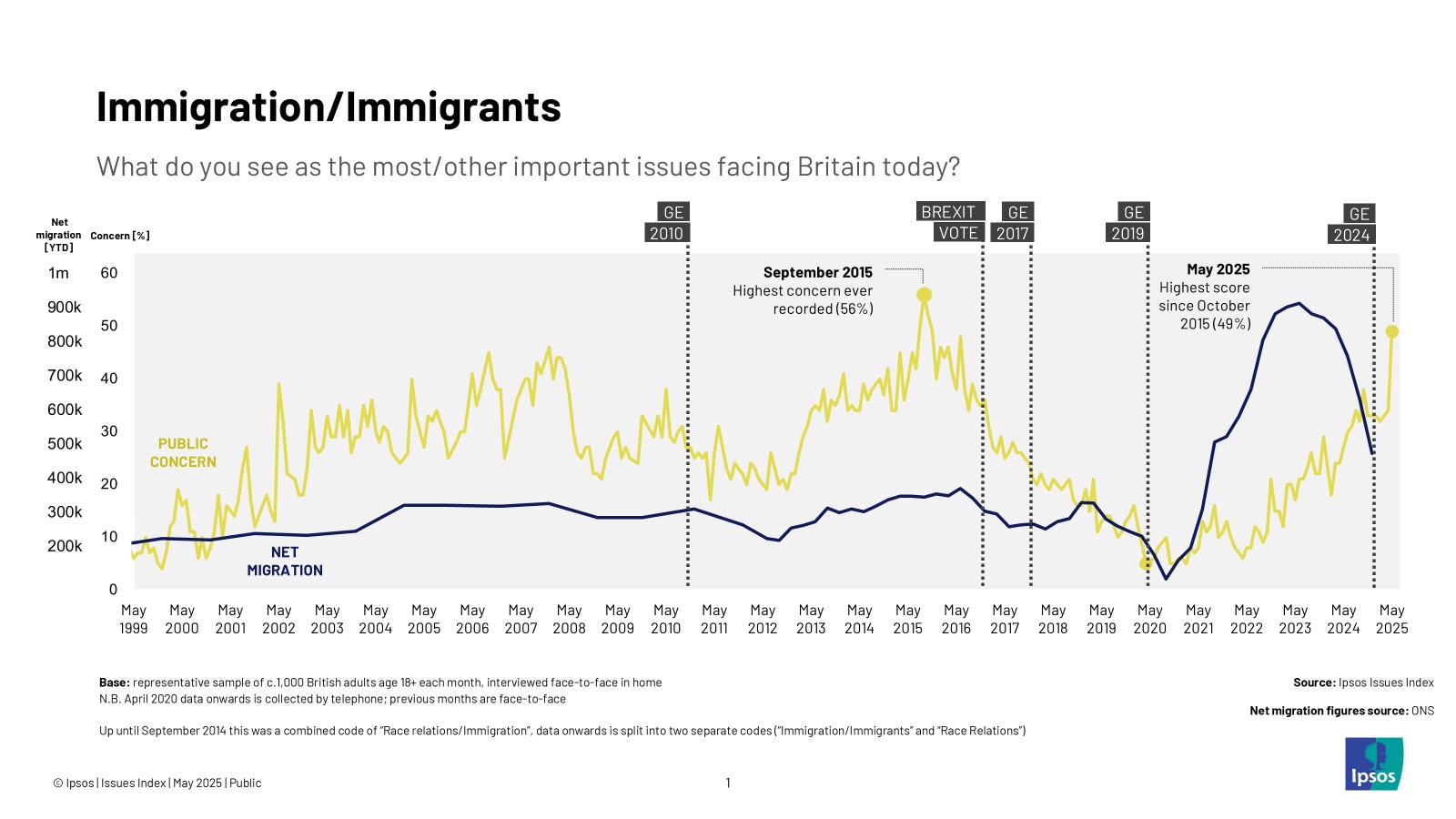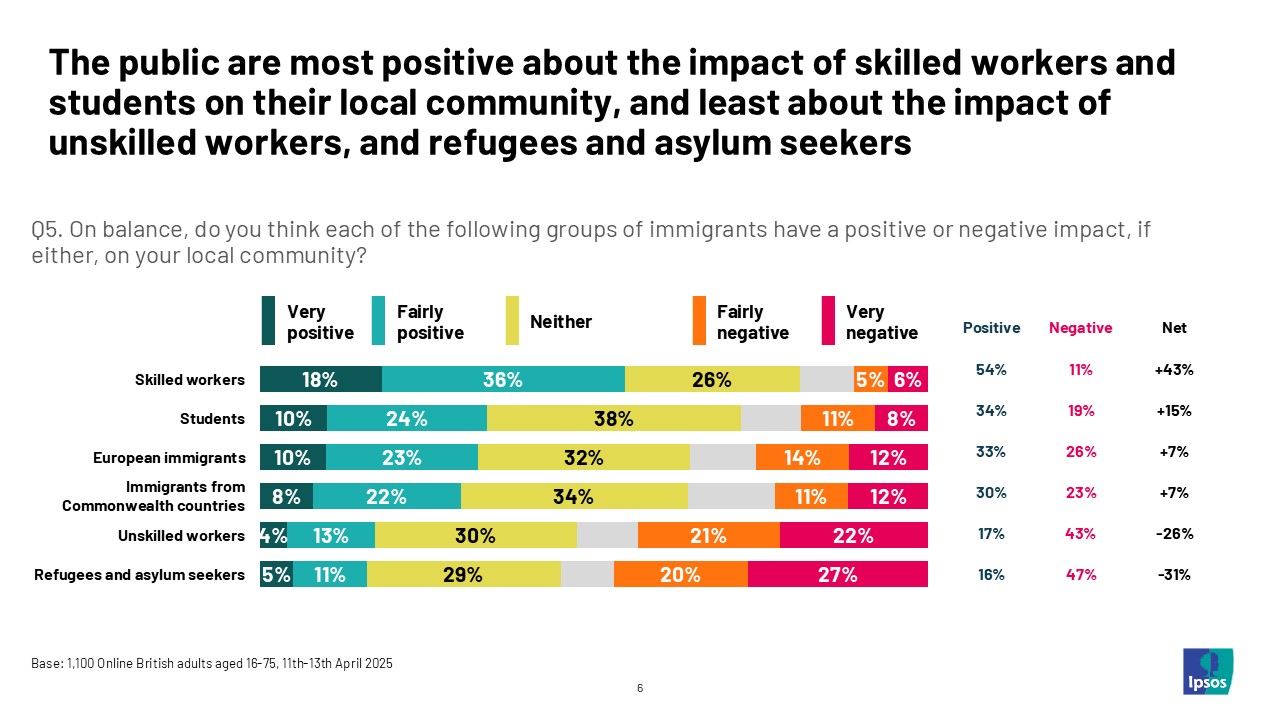Migration, Skills, and Public Trust: Rethinking the UK's Policy Approach
Concern with immigration has been steadily increasing since 2022, alongside a steep increase in net migration. In May 2025, half of Britons (49%) believed immigration was one of the most important issues facing the country, up from 34% in April – the highest score since October 2015. Whether the recently announced reduction in immigration figures ease some of the concern remains to be seen. The Government should take this opportunity to reconsider the role of immigration in addressing labour market demands through the implementation of its Immigration White Paper.

Source: Ipsos Issues Index, ONS
The focus on reducing immigration in the White Paper appeals to the public’s overall concerns about immigration. Before the most recent figures were announced, a majority (67%) told us they thought the total number of people coming to the UK is too high, as we found support for reducing the number of visas given out (54% support, and only 17% oppose).
At the same time, we find similar levels of support for making it easier for skilled people to move to the UK (56% support, 16% oppose), underpinned by generally positive attitudes towards skilled migration. Skilled workers are seen to have a positive impact on local communities (+43% net positive), followed by students (+15% net positive), while unskilled workers are more likely to be seen to have a negative impact (-26% net).

Our work with British Future shows that the role of immigrants, across all skill levels, in helping fill labour shortages is not lost on the general public, with one in two (49%) saying that addressing skill shortages at all levels should be the priority when allocating work visas, and only three in ten (30%) preferring a focus purely on attracting those with high skills. Yet this does not lead to support for solving skills shortages through immigration: we find that the public is split on whether it should be easier for people to come to the UK to take jobs in sectors with employment shortages (39% support, 33% oppose).
Further complexities come from a gap between perceptions of immigration and the reality of who is coming to the UK. Research by Ipsos and British Future shows that when people think about ‘immigrants’, less than half associate them with people who come to the UK to work. They might think of other groups like asylum seekers, students, or family members. This is despite the fact that work-related migration makes up a significant share of overall numbers (40%1).
The Government can display control over the immigration system while addressing labour market needs
Successive governments have set priorities around a net reduction in immigration. This narrow focus on numbers risks further alienating the public that shows high levels of scepticism around whether the government can reduce net migration (57% say it is unlikely, though this might change given the recently announced reduction in net migration), and it misses an opportunity to support the labour market.
Some of the proposed changes, such as lengthening the pathway to citizenship, may appear tough but carry the risk of deterring high-skilled workers from coming to the UK, particularly in sectors like health and social care that rely heavily on migrant labour23. Furthermore, the immediate implementation of stricter immigration controls - without a phased transition - risks creating labour shortages in essential, lower-paid sectors such as social care and hospitality. While the long-term objective is to bolster the domestic workforce, the absence of transitional measures may lead to short-term disruptions. A more balanced approach could involve short-term allowances for recruiting overseas workers in critical sectors, combined with robust investment in domestic training programs to ensure a smooth transition.
Rather than pursuing net migration reductions alone, a more effective strategy could focus on the broader impacts of immigration on the economy, public services, and communities. A policy framework that considers the role of migration in meeting workforce needs, especially in essential sectors, is more likely to maintain public confidence while supporting national priorities.
This means shifting the debate from numbers to outcomes: how immigration supports the NHS, fills skill shortages, and contributes to economic resilience. A more balanced and evidence-led approach can offer both reassurance and results; demonstrating control without losing sight of the contributions migration continues to make to the UK. At the same time, the government should directly address public concerns around unskilled migration by outlining plans to ensure that unskilled migrants are integrated effectively into the workforce and contribute positively to the economy through introducing safeguards or training programmes.
If the lower migration figures do lead to an ease in concern among the general public, the Government has an opportunity to do this now.
- https://www.gov.uk/government/statistics/immigration-system-statistics-year-ending-december-2024/summary-of-latest-statistics
- https://commonslibrary.parliament.uk/research-briefings/cbp-7783/#:~:text=Most%20NHS%20staff%20in%20England,staff%20with%20a%20known%20nationality
- https://www.skillsforcare.org.uk/Adult-Social-Care-Workforce-Data/Workforce-intelligence/publications/Topics/Workforce-nationality-and-international-recruitment.aspx



